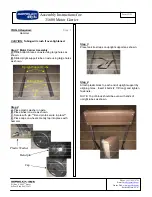
General information
6
vessel will be able to determine how best to
avoid you.
Give-way vessel
The vessel which does not have the right-of-
way has the duty to take positive and timely
action to stay out of the way of the Stand-On
vessel. Normally, you should not cross in
front of the vessel with the right-of-way. You
should slow down or change directions brief-
ly and pass behind the other vessel. You
should always move in such a way that the
operator of the other vessel can see what
you are doing.
“The general prudential rule”
This rule is called Rule 2 in the International
Rules and says,
“In obeying and construing these rules due
regard shall be had to all dangers of naviga-
tion and collision, and to any special circum-
stances, which may render a departure from
the above rules necessary in order to avoid
immediate danger.”
In other words, follow the standard rules ex-
cept when a collision will occur unless both
vessels try to avoid each other. If that is the
case, both vessels become “Give-Way” ves-
sels.
EMU25520
Rules when encountering vessels
There are three main situations which you
may encounter with other vessels which
could lead to a collision unless the Steering
Rules are followed:
Meeting:
(you are approaching another ves-
sel head-on)
Crossing:
(you are traveling across the oth-
er vessel’s path)
Overtaking:
(you are passing or being
passed by another vessel)
In the following illustration, your boat is in the
center. You should give the right-of-way to
any vessels shown in white area (you are the
Give-Way vessel). Any vessels in the shad-
ed area must yield to you (they are the Give-
Way vessels). Both you and the meeting
vessel must alter course to avoid each other.
Meeting
If you are meeting another power vessel
head on, and are close enough to run the risk
of collision, neither of you has the right-of-
way! Both of you should alter course to avoid
an accident. You should keep the other ves-
sel on your port (left) side. This rule doesn’t
apply if both of you will clear one another if
you continue on your set course and speed.
Crossing
When two power driven vessels are crossing
each other’s path close enough to run the
risk of collision, the vessel which has the oth-
er on the starboard (right) side must keep out
of the way of the other. If the other vessel is
on your right, you must keep out of its way;
you are the Give-Way vessel. If the other
Содержание Z250D
Страница 1: ...Z250D LZ250D Z300D LZ300D OWNER S MANUAL 6D0 28199 12 U S A Edition LIT 18626 06 09...
Страница 2: ...EMU25071 ZMU01690 Read this owner s manual carefully before operating your outboard motor...
Страница 79: ...74 Consumer information EMU29811 Important warranty information for U S A and Canada...
Страница 80: ...Consumer information 75...
Страница 81: ...Consumer information 76 EMU29820 YAMAHA MOTOR CORPORATION U S A OUTBOARD MOTOR TWO YEAR LIMITED WARRANTY...
Страница 82: ...Consumer information 77...
Страница 83: ...Consumer information 78...
Страница 84: ...Consumer information 79 EMU29840 IMPORTANT WARRANTY INFORMATION IF YOU USE YOUR YAMAHA OUTSIDE U S A OR CANADA...
Страница 85: ...Printed in Japan April 2004 0 4 1 Printed on recycled paper...
Страница 87: ...PLACE POSTAGE HERE ATTN WARRANTY DEPARTMENT Warranty card 2 27 02 11 47 AM Page 2...












































